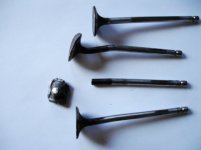COMP461
Comp Diesel Sponsor
- Joined
- Apr 23, 2006
- Messages
- 4,009
Spring pressure will not hurt a valve, a ProStock engines uses a 6 mm valve and over 500 lbs of spring pressure. A Cummins with a stock valve is 7 mm.
I really feel that any thing over 100 is more then sufficient on any street cam. As you get to the race only cams, it’s not RPM that is a problem, but the ramp acceleration rates. The spring pressure needed to keep the valve train controlled on one of the motors is no more then 125. I used 125 lbs spring on the Nitro Flash engine. This pressure is sufficient for 6000 RPMs
I really feel that any thing over 100 is more then sufficient on any street cam. As you get to the race only cams, it’s not RPM that is a problem, but the ramp acceleration rates. The spring pressure needed to keep the valve train controlled on one of the motors is no more then 125. I used 125 lbs spring on the Nitro Flash engine. This pressure is sufficient for 6000 RPMs


